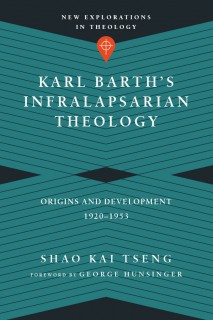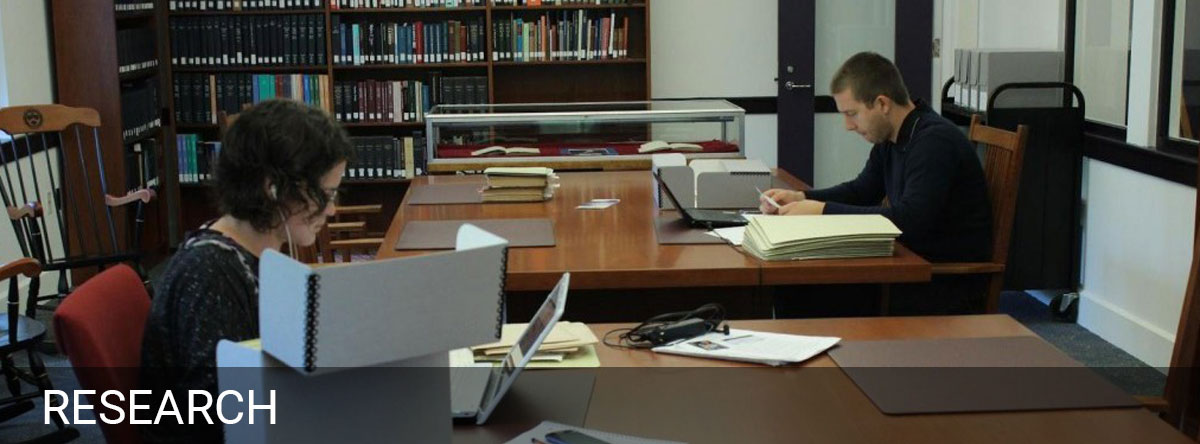 Tseng, Shao Kai. Karl Barth’s Infralapsarian Theology: Origin and Development, 1920–1953 (Downers Grove, IL: IVP Academic, 2016), 319 pp. $39.00 (paperback).
Tseng, Shao Kai. Karl Barth’s Infralapsarian Theology: Origin and Development, 1920–1953 (Downers Grove, IL: IVP Academic, 2016), 319 pp. $39.00 (paperback).
Reviewed by Chet Harvey (January 10, 2017)
Shao Kai Tseng’s Karl Barth’s Infralapsarian Theology is an analysis of Karl’s Barth’s theology related to the lapsarian question, which concerns the logical ordering of God’s decrees of fall and incarnation. The received wisdom has been to read Barth as a supralapsarian, both because of his own self-designation as “purified supralapsarian” as well as his formulation of the doctrine of election. Tseng has the lofty goal in this work of renaming Barth’s beliefs as basically infralapsarian. The book’s two-fold thesis is developed over two major sections. Tseng’s first thesis is that Barth’s mature formulation of the doctrine of election involves “a dialectical combination of both lapsarian positions,” including an infralapsarian position on the object of election and the order of the divine decrees (29). His second thesis is that Barth’s struggles with the lapsarian question “are in fact one important factor driving his theological development” (34). Tseng’s major goal in this work is to place Barth’s theology related to the lapsarian question within the broader context of Reformed theology.
The first major section, comprising chapters one and two, offers an assessment of Barth’s lapsarian position. In chapter one, Tseng argues that Barth’s understanding of the seventeenth century lapsarian debate is deficient, and therefore his definitions of the terms, particularly infralapsarianism, are inaccurate. Barth’s most notable error is his description of infralapsarianism as insinuating a chronological, rather than logical, ordering of the decrees. In chapter two, Tseng examines Barth’s fullest treatment of the lapsarian question in CD II/2 to assess his reasons for claiming supralapsarianism and his actual implicit position. According to Tseng, Barth is averse to infralapsarianism for two major reasons. First, he believes it is a result of metaphysical speculation rather than God’s revelation in Christ. Second, he believes that it implies a disruption in God’s original plan for creation. As Tseng emphasizes in chapter one, this is based on Barth’s misunderstanding of the nature of the decrees in the infralapsarian system as chronological rather than logical. In assessing Barth’s actual lapsarian position, Tseng contends that it is best understood dialectically, being basically infralapsarian but also containing supralapsarian elements. Particularly, Barth’s description of the incarnation as response to human fallenness suggests infralapsarianism, but the teleological priority he gives to election suggests supralapsarianism.
The second major section, comprising the remainder of the book, moves chronologically through several of Barth’s major writings to show how his own position develops and the impact that his assessment of the lapsarian question has on other major theological formulations. One of Tseng’s contentions in this section is that Barth’s mature Christology, which is basically infralapsarian in its description of the incarnation as the result of humanity’s fall, comes to undergird his doctrine of election, which early in his career is basically supralapsarian in its ordering of election and the fall. Chapters three, four, and five offer assessments of his doctrines of revelation, election, and Christology during the stage in his career when he hasn’t yet brought them together. Chapter three explores Barth’s Römerbrief II, a work built upon the dialectic of the impossible-possibility of revelation. Tseng argues that in this early period of his career, Barth’s doctrine of election is basically supralapsarian because he describes God’s election on the eternal-eschatological level as determining humanity’s fall into sin on the historical level. However, infralapsarian strands can be seen in his doctrines of revelation and Christology, both predicated on human fallenness.
Chapter four continues with the Göttingen Dogmatics, where Barth’s Christology suggests infralapsarianism in his description of the incarnation as made necessary by humanity’s sin. Tseng points out that during this period of his career, Barth moves toward an actualistic understanding of election, thus eliminating his earlier separation of the eternal and historical levels, and therefore removing a supralapsarian strand from his theology. Specifically, “the incarnation as the objective aspect and election as the subjective aspect of revelation as such are both predicated on humanity’s fallenness” (183).
The groundwork for merging his doctrines of Christology and election begins during Barth’s years at Bonn, which is the subject of chapter five. His doctrine of election in this period contains infralapsarian strands in its description of election as necessary because of human fallenness. However, it could still be considered basically supralapsarian because he grounds each person’s faith or unbelief in God’s eternal decision, suggesting a supralapsarian double-predestination. Tseng proposes a basic contradiction in this period, later remedied, between the methodological conviction that God-talk must be through Christ and his own doctrine of election, grounded in God’s eternal decision apart from Christ.
In chapter six, Tseng contends that Barth’s infralapsarian Christology becomes a chief factor in the reformulation of his doctrine of election in 1936, a time period marked by Bruce McCormack and others as “the beginning of the mature phase of Barth’s theology” (177). There has been some debate concerning the influences on Barth’s reformulation, with Pierre Maury’s lecture on Calvin’s doctrine of predestination considered by many as a major factor. Tseng’s argument is that Barth’s answer to the lapsarian question is a major factor in his new formulation of election adopted in his 1936 work Gottes Gnadenwahl, which reveals a correspondence between the works of Christ and the eternal being of God that removes his earlier contradiction. In this formulation, election becomes “God’s eternal decision to become incarnate,” and thus both predestination and reprobation are viewed in light of Christ (192). As Tseng has already demonstrated, incarnation is a response to human fallenness, and therefore there is an infralapsarian element within his new doctrine of election.
Chapter seven continues the analysis of Barth’s movement towards a full-fledged Christocentric doctrine of election by examining CD II/2, where election becomes for Barth the sum of the Gospel. The central idea of election in CD II/2 is that Jesus Christ is both electing God and elected human, and thus the doctrine of election is known through Jesus Christ. Once again, Barth reveals a dialectical engagement with election in relation to creation. On the supralapsarian side, Barth implies a logical precedence of election over creation in God’s decrees. However, on the infralapsarian side, Barth explains fallenness as the reason for the incarnation. In this work, he claims his lapsarian position as “purified supralapsarianism,” and Tseng explains that in doing so Barth is critiquing the error of separating God’s eternal decrees from God as revealed in Christ in the classic rendition of supralapsarianism. For Barth, Jesus Christ is the object of God’s eternal election, and humanity indirectly becomes the object through participation in Christ.
The eighth chapter concludes Tseng’s analysis of Barth’s work by discussing his theology of sin in CD IV/1. Tseng argues in this chapter that Barth’s christological doctrine of sin is grounded in an infralapsarian understanding of human fallenness. Specifically, God’s Yes in Christ is presupposed by God’s No to the Adamic-history, or history of fallenness, of the world. Tseng enters into the multi-layered current debate surrounding the relationship between Trinity and election in order to show further infralapsarian strands to Barth’s Christology. In particular, Tseng argues that Christ enters into this world-history by taking on human nature as a result of human fallenness. In Tseng’s words, “The incarnation is the history of the electing God’s entrance into the history of God’s fallen covenant partner, in order to sublate the latter’s history of fallenness for the sake of and in the election of all in Christ” (289).
In this work, Tseng presents both a provocative and robust account of Barth’s theology related to the lapsarian question. Both parts of his thesis are sure to draw scholarly engagement for some time. Concerning his first thesis, readers might not be convinced by Tseng’s argument that Barth’s position should be labelled as basically infralapsarian. For Tseng, the deciding factor is Barth’s consistent treatment of humanity as the sinful and lost object of election, which falls squarely on the infralapsarian side of what is considered the basic question of the classic lapsarian debate. However, Tseng’s analysis shows justification for claiming Barth as a purified supralapsarian with infralapsarian strands. Tseng himself demonstrates throughout the work that Barth does not fit neatly within either category, and without dialectic lenses his position can appear either inconsistent or contradictory.
Related to Tseng’s second, larger thesis, it would be difficult to argue against his thorough analysis of Barth’s position and its impact upon his doctrinal formulations. In fact, this is where Tseng’s work shines brightest. He clearly explains complex issues within Barth’s theology, always with an eye to the effect of Barth’s lapsarian conclusions on other doctrinal developments. Most importantly, Tseng demonstrates that the lasparian question can act as a hermeneutical key for discerning the impetus of several major elements of Barth’s theology. However, this work is intricate and at times laborious in its process of ascertaining Barth’s position, and Tseng’s own engagement with current scholarship requires some background knowledge. For readers with this knowledge, this work is highly recommended.
Chet Harvey, Ph.D. Student, Southeastern Baptist Theological Seminary
The views expressed here are strictly those of the author; they do not necessarily represent the views of the Center for Barth Studies or Princeton Theological Seminary.


